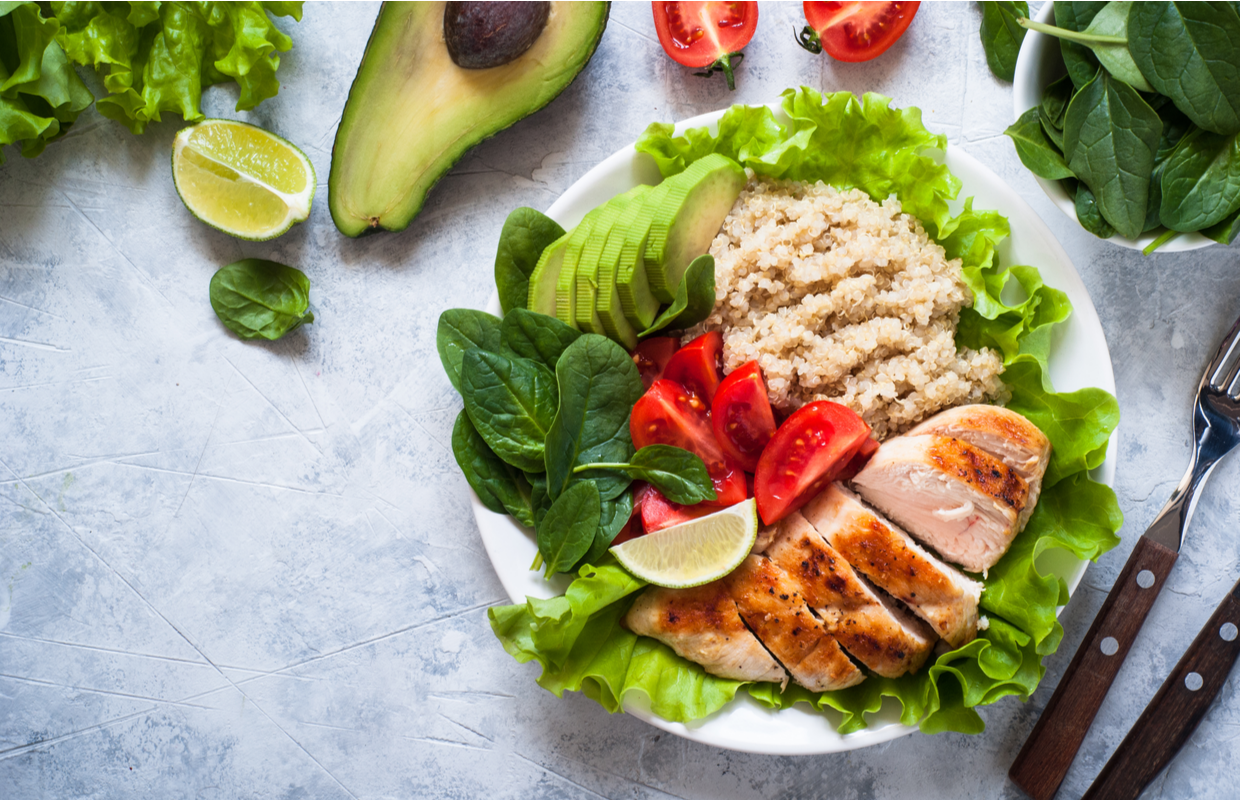Want to stay in shape, get lean or improve your muscle mass? Then it helps to understand the basics of macro counting, says nutritionist Christine Bailey. Here’s how to count your macros for healthy weight management…
Have you ever envied someone in the gym who stays in shape and appears to eat whatever they want? The chances are they have a good understanding of not only how much they need to eat but also how to hit their macro targets. Whatever your fitness or health goal, learning how to manipulate your intake of fats, proteins and carbohydrates will make it much easier to see results.
What are macros?
Macronutrients, or ‘macros’, are nutrients your body needs in large quantities. They are also where your calories come from. There are three main types of macros in food: protein, carbohydrates and fat. Each macro provides different health and nutritional benefits. Protein has four calories per gram, carbohydrates have four calories per gram and fat has nine calories per gram.
Alcohol is also considered a macro, with seven calories per gram, because it provides calories to your diet. However, it is not typically considered in macro ratios because it does not provide any nutritional value.
When it comes to balancing your macros, there isn’t a one-size-fits-all approach. The percentage of each macronutrient that makes up your diet will be influenced by your health, fitness goals and the type of exercise you regularly do. That’s why an endurance cyclist is likely to require a higher percentage of carbohydrates than someone who focuses on weightlifting.
What are the 3 macros categories?
Each macronutrient is used a little differently by the body. Understanding how each one supports your daily health and fitness needs is important…
- Carbohydrates (oats, fruit, pasta, etc) are the preferred source of energy. Excess carbohydrates can be stored as glycogen in your muscles for fuel or stored as body fat.
- Fat is a source of longer-term energy. Our bodies can use it as immediate fuel or store it as body fat. Some fats, such as the omega-3 fatty acids, are considered essential. This means we cannot make them and they have to come from our diet.
- Protein (meat, fish, dairy, soy, etc) is often viewed as the ‘builder’ macro. This is because our bodies use it to build and maintain cells throughout the body, including your DNA, bones and muscle mass.
By changing the balance of macros in your diet, you can impact your exercise performance and how easy you find it to build muscle, lose fat or manage weight.

How to count macros
When it comes to body composition, most people are either looking to build muscle, lose fat or maintain their current weight and composition. The total number of calories you eat, and how those calories break down into protein, carbs and fat, play an important role in your weight and body composition. Counting macros can help.
In order to work out your macros requirements, you first need to know your daily calorie target based on your goal (to gain muscle, lose fat, etc) and then you can work out how many grams of protein, fat and carbohydrates you need.
The easiest way to work this out is to use an online calculator. Typically, these will ask you for your gender, weight, height, age and activity level, before providing an estimate of your basal metabolic rate (BMR) and total daily energy expenditure (TDEE). Once you have your TDEE, you can determine how many calories you should be eating based on your goal.
Here’s a guide:
- If you want to lose weight, aim to eat around 80 percent of your TDEE, or 20 per cent less energy than you’re burning every day.
- If you’re looking to gain weight, aim to eat around 110 per cent of your TDEE, or 10 per cent more energy than you’re burning.
- Or, if you want to maintain your weight, you should eat 100 per cent of your TDEE.
It is important to remember that your daily calorie intake figure is an estimate. If you are not getting the results you want after a few weeks, you may need to adjust it.
Follow this guide to tot up your daily macronutrient needs.
5 tips to successfully count your macros
- Calculate your daily calorie intake based on your goals.
- Calculate your protein intake in grams or as a percentage. If using grams, multiply by four to get the calories of protein.
- Calculate your fat intake. If using grams, multiply by nine to get the amount of calories.
- Calculate your carbohydrate intake, either use a percentage or, if you have already worked out the calories of fat and protein, add these together and subtract the number from your total calories. If you want to workout how many grams of carbohydrates, simply divide the number of carbohydrates calories by four.
- Adjust your calories and macro balance after a couple of weeks if you are not achieving your desired weight or fitness goals.

How many macros do I need?
Once you have your daily calorie estimate, you can work out your daily macronutrient needs.
Protein:
Your daily protein requirements will be influenced by your body weight, fitness, lean muscle mass and your goals. Protein can support your workout recovery, plus help you to gain muscle mass and lose fat faster, and to feel fuller from your meals.
Protein, and especially how much of it to eat, is frequently debated when it comes to fitness. The truth is, everyone is different. While the general recommendations are to consume around 0.8g of protein per kilogram of bodyweight, for women who are active and/or trying to lose weight, more than this will get better results.
A good guideline is between 1.2-1.8g of protein per kilogram of body weight. This means, if you weigh 57kg (nine stone), your protein needs are likely to be between 68.4-114g per day. However, this depends on your health and fitness goals. For greater accuracy, you can base protein intake on lean muscle mass rather than total body weight.
The alternative approach is to base your protein intake using a macronutrient percentage. This might be, for example, 40 per cent carbohydrates, 30 per cent protein and 30 per cent fat. In some cases, this can lead to a higher protein intake – for example, if your calorie intake is very high.
If you’re very overweight, then it maybe better to use a lower percentage (think 20-30 percent of your daily calories) or base it on your lean body mas. Otherwise your protein intake may be too high. When choosing foods for protein, consider the amino acid content. There are nine essential amino acids that we need to eat because our bodies cannot make them from other molecules.
All animal sources of protein will provide these essential amino acids. Most plant proteins tend to be low in one or more of these essential amino acids, so ensuring variety of plant-based proteins is important.
Fat:
Yes, we need fat! Dietary fat is an essential nutrient and plays an important role in many physiological processes, ranging from hormone production, cell health, cognitive health, to satiety and nutrient absorption. Too little fat can disrupt hormonal balance.
Research suggests for those who exercise regularly, fat intake should be around 20-35 per cent of the diet or around 0.5-1.5g per kilogram of body weight per day. If you are looking to lose weight, eating too much fat isn’t going to do your body any favours. Fat has nine calories per gram, so cutting back a little can make it easier to hit your daily targets.
It is recommended to focus on consuming more beneficial fats like those rich in monounsaturates (think avocado and olive oil) and polyunsaturates, especially the essential fats like omega-3 fatty acids found in oily fish, flaxseed and walnuts.
Carbs:
Probably one of the hottest topics now is how many carbohydrates to eat. If you exercise regularly, don’t be afraid of carbs! Carbohydrates provide the fuel for intense exercise, can help to top-up glycogen stores to support muscle growth and recovery, as well as providing various vitamins, minerals and fibre.
Carbohydrates also supply the glucose the brain uses to function, so ensure you’re consuming enough. One of the easiest ways to workout the amount of carbs to eat is to allot your remaining calories to them once you’ve worked out your protein and fat needs. Depending on fitness and health goals, it’s likely to be around 40-50 percent of your daily calories.

Summary: how to count macros
What is the best macro split? The truth is there isn’t. If you enjoy endurance sports, the chances are your intake of carbohydrates should be higher than if you are looking to build muscle in the gym.
That said, if your goal is to lose body fat and your regular workout routine includes weights and cardio, you may want to try a 40/30/30 split. This means 40 per cent of calories from carbohydrates, 30 per cent from protein, and 30 percent from fats. Remember, everyone is different. There is no magic formula and some people do better with more or less carbs or protein.
It’s equally important to monitor progress. If you are not experiencing improvements after a couple of weeks, you may need to tweak the macros and calories. Remember also that the quality of food you consume is important. When used properly, counting macros can provide plenty of flexibility over what you can eat. However, that shouldn’t mean a diet of processed foods.
You want to be consuming foods that provide the right vitamins, minerals, fibre and antioxidants. For this reason, aim to get at least 80 percent of your daily calories from minimally processed and nutritious foods that you enjoy. Look to have variety and colour on your plate each day to keep your diet nutrient dense.
Try a macro meal delivery service:
If you want support with eating for your goals, look for a tailored meal service. Fresh Fitness Food is a personalised ‘ready-to-eat’ meal delivery service. The brand creates bespoke macro-based meals that are delivered ready for you to eat. It’s easy to use, too – simply add your details and health goals and they will deliver meals to suit your aims. From £15 for two daily meals.
Related: Post-workout nutrition – what to eat after exercising
Words: Christine Bailey | Images: Shutterstock








